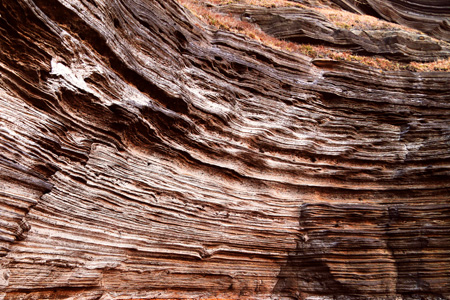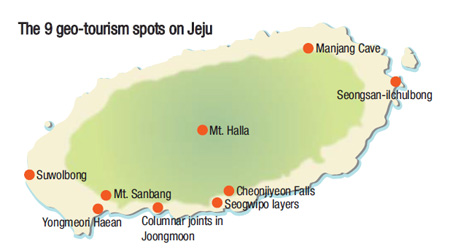- California Assembly OKs highest minimum wage in nation
- S. Korea unveils first graphic cigarette warnings
- US joins with South Korea, Japan in bid to deter North Korea
- LPGA golfer Chun In-gee finally back in action
- S. Korea won’t be top seed in final World Cup qualification round
- US men’s soccer misses 2nd straight Olympics
- US back on track in qualifying with 4-0 win over Guatemala
- High-intensity workout injuries spawn cottage industry
- CDC expands range of Zika mosquitoes into parts of Northeast
- Who knew? ‘The Walking Dead’ is helping families connect
The 9 geo-tourism spots on Jeju
By Yun Suh-young
Jeju Island has always been a popular destination for travelers in search of natural beauty and serenity.
There are so many places to go on Korea’s most-visited resort island, and if you are wondering which to pick and choose, borrowing a list from UNESCO wouldn’t be a bad idea.
In 2010, the island was included in the Global Geoparks Network (GGN), a UNESCO assisted project aimed at the promotion and preservation of geological heritage.
Jeju qualified on the strength of nine key sites that convey the unique value of the island’s beauty — Mt. Halla, Manjang Cave, Seongsan-ilchulbong, Cheonjiyeon Falls, Seogwipo layers, columnar joints in Joongmoon Daepo, Mt. Sanbang, Yongmeori Haean, and Suwolbong.
In an effort to capitalize on the UNESCO listing, the Jeju Tourism Organization is planning to develop trail routes around the nine spots, focusing on places that don’t have proper trails at the moment. The trails are expected to open by June at the latest although some may open earlier.
A panoramic view
Of course, many of the nine key destinations are already well-known. However, Suwolbong, a 77-meter high tuff ring, remains underexposed, and considering its majestic beauty and the unforgettable view, that’s an injustice.
The landform was created from an explosive interaction of magma, ground and water that scientists believe happened about 18,000 years ago, and is protected as a state-designated natural monument.
Walking around the area, visitors might feel as if they have dropped onto a mini-version of the Grand Canyon with its steep slopes of layered rock.
The colors of the sedimentary rock layers change depending on the time of the day or the weather. It dazzles visitors with the orangey-red color on a sunny day and turns pitch brown when soaked in rain.
Watching a sunset at Sulwolbong might be the most beautiful sight on Jeju, providing a panoramic view of the ocean splashed with intense colors of orange and yellow.
Suwolbong has three trails that visitors can trek along, with residents working as guides to help first-time visitors.
Among the routes, the best one is a 4.2 kilometer trail starting from the Haenyeo’s House and ends at Jagunae Pogu or Jagunae Harbor. This is the route that allows you to walk along the coast right below the tuff ring. It’s hard to say the trail is neatly polished, but the stunning scenery is well worth the bumpy experience.
Viewing, trekking, and photographing
Yongmeori Haean, which roughly translates as “dragon head coast,” is another underrated traveling spot. This is part of another volcanic landscape and its name reflects its otherworldly shape. Viewed from above, a long-stretching cliff atop the rock layers does resemble the neck of a mystical flying serpent.
Yongmeori Haean is a more accessible place for travelers to visit than Suwolbong and tourism authorities are developing new routes they hope will help increase the influx of visitors.
Currently under construction are trails that connect Yongmeori Haean with local destinations in the vicinity such as Mt. Sanbang.
The existing trail which visitors can trek along at the moment is a course along the beach below the cliff. Starting from the parking lot at Yongmeori Haean, this route ends at the stairways leading up to the parking lot of Mt. Sanbang, which is another geo-tourism spot. Visitors can choose to end their walk at that point or return to where they started. The walk along the coast from one end to the other takes about 40 minutes at a slow pace.
Along the coast, local residents sell seafood that they cut and serve raw on the spot.
The Yongmeori Haean is open from 8 a.m. to 6 p.m. from May to September and from 8:30 a.m. to 5:30 p.m. during the winter period between January until April and October to December. However, visitors must check the weather conditions first because entry is limited when the tide is high.
Another thing to remember is not to wear high heels or uncomfortable shoes because the trail is extremely rocky. Wear sneakers or comfy shoes to enjoy the walk.


















